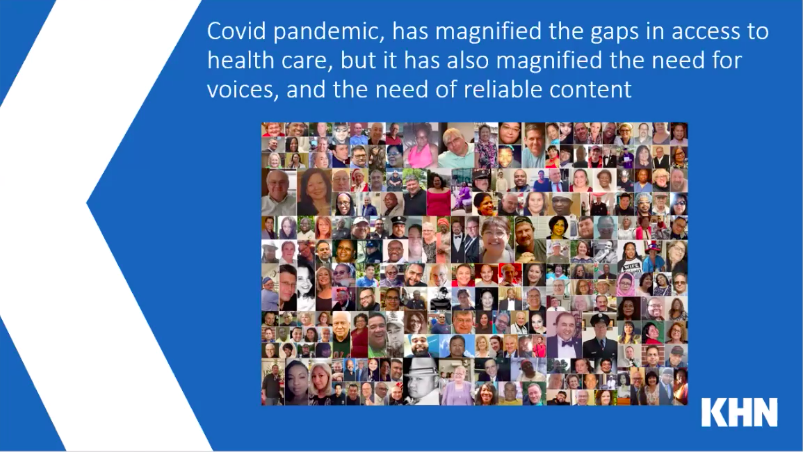by Kathryn Cleary
On 18 March, the Internews Health Journalism Network hosted an exciting webinar focussed on filling the gaps in health news across the world. We featured speakers Paula Andalo, Ethnic News Editor of Kaiser Health News in the United States, and Ahmed Abdeen, an Internews Pandemic Mentor and also the founder of Aleyada.com, the first health news website in the Middle Eastern North African (MENA) region to be solely in Arabic.

The COVID-19 pandemic revealed an immediate and pressing need for quality, timely and accessible health reporting around the globe, forcing journalists and newsrooms to learn new skills and adapt to new challenges. Being able to balance the amount of new information coming in about COVID-19 each day, as well as ensuring the information includes different voices and community perspectives is one of these challenges.
Food for thought: how have you or your newsroom worked to fill the gap in health reporting in your country?
Both Andalo and Abdeen have years of experience working in info-poor areas, or with communities who seldom had news in a language they could understand. As COVID-19 took centre stage at the end of 2019 as one of the biggest health threats, both Andalo and Abdeen had to find new ways of filling these gaps in news, prioritising work to ensure that these info-poor areas and communities had access to potentially life-saving news.
Andalo’s work with Kaiser Health News has allowed her to promote diversity in media coverage by working to better reach latin american audiences by translating stories into Spanish, as well as working to include spanish speakers and communities in health stories. With the United States’ growing hispanic population, including this demographic in news and specifically health news, is critical.

Kaiser Health News’ stories can also be re-published by other media outlets for free, which means that health news stories that have been translated into Spanish can be shared with other Spanish-speaking news outlets, like Telemundo.
Andalo says that you can’t have a democratic media without including different demographics. She emphasizes that all journalists in any newsroom should be able to work with sources from any background.
“Diversity is democracy, and vice versa,” says Andalo
Adding to this, Abdeen says that Aleyada.com was established as a way to fill the gap in health news for arabic speakers in the MENA region. Internews and Abdeen worked to support journalists in the region to produce health news in Arabic, but without a platform to publish these stories, Aleyada.com was formed. This is the first website of it’s kind dedicated to health news in Arabic.
Before Aleyada, there was no source of information in Arabic that the region’s over 400 million Arabic speakers could trust or refer to for quality health news, says Abdeen.
Food for thought: Are there media platforms in your country that are dedicated to health news?
Responding to a question from an attendee, Andalo says that reporting on COVID-19 has had similarities with the HIV/AIDS epidemic in the US in the 1980s, in the sense that early reporting was, and still is, largely based on what was unknown or uncertain. “The masks now are what condoms were in the 80s, because we need to use it,” she adds.
COVID-19 has also forced media to confront societal prejudice and discrimination similar to the challenges members of the LQBTQI+ community were treated during HIV/AIDS, says Andalo.
Balancing health science and human interest stories can also be challenging, particularly during a pandemic. Andalo says that it’s important to balance the heavy science with “human faces,” and to use reliable scientific information in a high-quality way that’s accessible to readers. Abdeen builds on this and agrees that taking complex scientific concepts and language and making it easy and simple to understand is crucial.
To end off, Andalo says that health reporting is relevant to everybody, and crosses over all areas of news, but it’s an ongoing effort to make this media democratic through diversity.
“COVID-19 is opening the space for health coverage similar to what HIV-AIDS did in the past,” she says. “Hopefully when the pandemic ends, we will still have this space [for health journalism].”